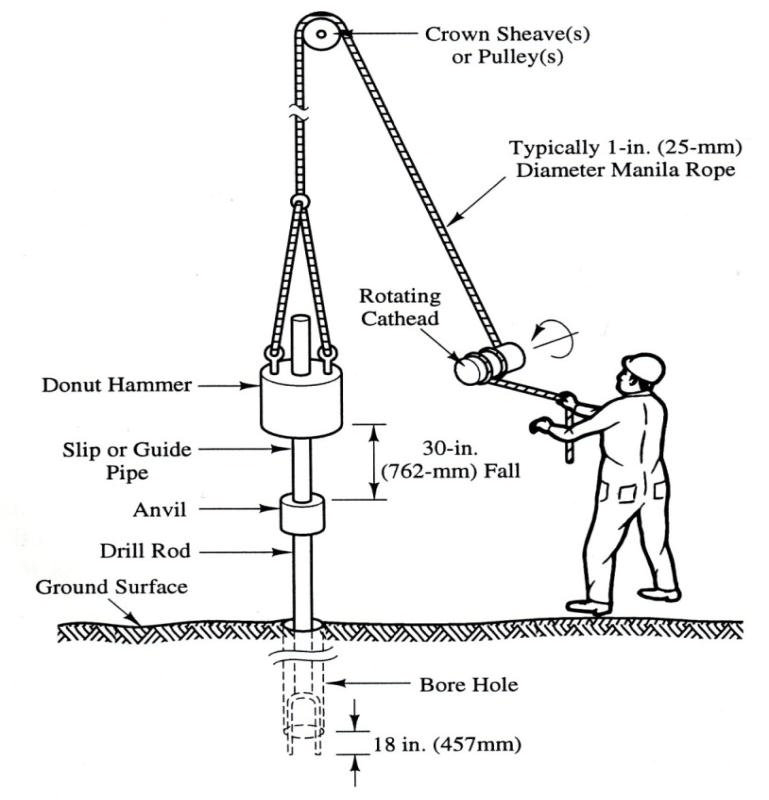The Standard Penetration Test (SPT) is a widely used in-situ testing method to determine the geotechnical properties of subsurface soils. It is primarily used to assess the relative density, strength, and other properties of granular soils, as well as the consistency of some cohesive soils. The SPT provides a measure of soil resistance to penetration, which is valuable for evaluating the soil’s load-bearing capacity and other engineering properties.

SPT Procedure
- Drilling a Borehole: A borehole is drilled to the desired depth using a drilling rig. The borehole diameter typically ranges from 60 mm to 150 mm.
- Placing the Sampler: A standard split-barrel sampler (also known as a split-spoon sampler) is lowered to the bottom of the borehole. The sampler has an outer diameter of 50.8 mm (2 inches) and an inner diameter of 35 mm (1.38 inches).
- Driving the Sampler: The sampler is driven into the soil by dropping a 63.5 kg (140 lb) hammer from a height of 760 mm (30 inches). The hammer is repeatedly dropped, causing the sampler to penetrate the soil.
- Recording Blow Counts: The number of hammer blows required to drive the sampler each of three successive 150 mm (6 inch) intervals is recorded. The first 150 mm of penetration is considered a seating drive and is not included in the final count. The blow counts for the second and third 150 mm intervals are added together to obtain the SPT N-value (blows per foot).
- Retrieving the Sampler: After the test is completed, the sampler is retrieved from the borehole. The soil sample collected inside the split-barrel sampler is examined and classified.
Interpretation of SPT Results
- SPT N-value: The SPT N-value is the total number of blows required to drive the sampler the second and third 150 mm (6 inch) intervals (total 300 mm or 1 foot). This value provides a measure of the soil’s resistance to penetration and is used to estimate various soil properties.
Typical Ranges of SPT N-values
- 0-4: Very loose (cohesionless soils) or very soft (cohesive soils)
- 5-10: Loose (cohesionless soils) or soft (cohesive soils)
- 11-30: Medium dense (cohesionless soils) or firm (cohesive soils)
- 31-50: Dense (cohesionless soils) or stiff (cohesive soils)
- >50: Very dense (cohesionless soils) or very stiff (cohesive soils)
Uses of SPT N-values
- Soil Classification: SPT N-values are used to classify soil into categories such as very loose, loose, medium dense, dense, and very dense for granular soils, or very soft, soft, firm, stiff, and very stiff for cohesive soils.
- Bearing Capacity: Empirical correlations between SPT N-values and bearing capacity are used to estimate the allowable bearing pressure for foundations.
- Settlement Analysis: SPT N-values are used to estimate the potential settlement of foundations, particularly for shallow foundations.
- Liquefaction Potential: In seismic areas, SPT N-values are used to assess the liquefaction potential of sandy soils during earthquakes.
- Foundation Design: The N-values are utilized to design shallow and deep foundations, including determining the depth and type of foundation required.
Advantages of SPT
- Simplicity: The SPT is relatively simple and cost-effective compared to other in-situ tests.
- Wide Use: It is a well-established and widely accepted test with a large database of empirical correlations.
- Versatility: It can be used in various soil types and is especially useful for granular soils.
Limitations of SPT
- Disturbance: The test can disturb the soil sample, particularly in very soft or very loose soils.
- Operator Variability: Results can be affected by the skill and experience of the operator.
- Energy Efficiency: The energy delivered by the hammer can vary, affecting the consistency of results. Standardized corrections (such as the energy efficiency ratio) are often applied to account for this.
- Limited Depth: It is generally suitable for depths up to about 30 meters. For greater depths, other methods may be more appropriate.
Conclusion
The Standard Penetration Test (SPT) is a fundamental tool in geotechnical engineering for site investigations. Despite its limitations, it provides valuable information about soil properties and is extensively used for foundation design, soil classification, and assessing soil behavior. Proper interpretation of SPT results, considering the local geology and empirical correlations, is essential for accurate geotechnical analysis and design.